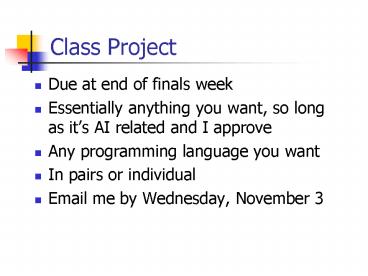Class Project - PowerPoint PPT Presentation
Title:
Class Project
Description:
Computer game players:Go, Checkers, Connect Four, Chess, Poker ... Too complicated games: Risk, Yahtzee, Chess, Scrabble, Battle Simulation ... – PowerPoint PPT presentation
Number of Views:80
Avg rating:3.0/5.0
Title: Class Project
1
Class Project
- Due at end of finals week
- Essentially anything you want, so long as its AI
related and I approve - Any programming language you want
- In pairs or individual
- Email me by Wednesday, November 3
2
Projects
- Implementing Knn to Classify Bedform Stability
Fields - Blackjack Using Genetic Algorithms
- Computer game playersGo, Checkers, Connect Four,
Chess, Poker - Computer puzzle solvers Minesweeper, mazes
- Pac-Man with intelligent monsters
- Genetic algorithms
- blackjack strategy
- Automated 20-questions player
- Paper on planning
- Neural network spam filter
- Learning neural networks via GAs
3
Projects
- Solving neural networks via backprop
- Code decryptor using Gas
- Box pushing agent (competing against an opponent)
4
What didnt work as well
- Too complicated games Risk, Yahtzee, Chess,
Scrabble, Battle Simulation - Got too focused in making game work
- I sometimes had trouble running the game
- Game was often incomplete
- Didnt have time to do enough AI
- Problems that were too vague
- Simulated ant colonies / genetic algorithms
- Bugs swarming for heat (emergent intelligence
never happened) - Finding paths through snow
- AdaBoost on protein folding data
- Couldnt get boosting working right, needed more
time on small datasets (spent lots of time
parsing protein data)
5
Reinforcement Learning
- Game playing So far, we have told the agent the
value of a given board position. - How can agent learn which positions are
important? - Play whole bunch of games, and receive reward at
end ( or -) - How to determine utility of states that arent
ending states?
6
The setup Possible game states
- Terminal states have reward
- Mission Estimate utility of all possible game
states
7
What is a state?
- For chess state is a combination of position on
board and location of opponents - Half of your transitions are controlled by you
(your moves) - Other half of your transitions are probabilistic
(depend on opponent) - For now, we assume all moves are probabilistic
(probabilities unknown)
8
Passive Learning
- Agent learns by watching
- Fixed probability of moving from one state to
another
9
Sample Results
10
Technique 1 Naive Updating
- Also known as Least Mean Squares (LMS) approach
- Starting at home, obtain sequence of states to
terminal state - Utility of terminal state reward
- loop back over all other states
- utility for state i running average of all
rewards seen for state i
11
Naive Updating Analysis
- Works, but converges slowly
- Must play lots of games
- Ignores that utility of a state should depend on
successor
12
Technique 2 Adaptive Dynamic Programming
- Utility of a state depends entirely on the
successor state - If a state has one successor, utility should be
the same - If a state has multiple successors, utility
should be expected value of successors
13
Finding the utilities
- To find all utilities, just solve equations
- Set of linear equations, solveable
- Changes each iteration as you learn probabilities
- Completely intractable for large problems
- For a real game, it means finding actual
utilities of all states
14
Technique 3 Temporal Difference Learning
- Want utility to depend on successors, but want to
solve iteratively - Whenever you observe a transition from i to j
- a learning rate
- difference between successive states temporal
difference - Converges faster than Naive updating
15
Active Learning
- Probability of going from one state to another
now depends on action - ADP equations are now
16
Active Learning
- Active Learning with Temporal Difference
Learning works the same way (assuming you know
where youre going) - Also need to learn probabilities to eventually
make decision on where to go
17
Exploration where should agent go to learn
utilities?
- Suppose youre trying to learn optimal game
playing strategies - Do you follow best utility, in order to win?
- Do you move around at random, hoping to learn
more (and losing lots in the process)? - Following best utility all the time can get you
stuck at an imperfect solution - Following random moves can lose a lot
18
Where should agent go to learn utilities?
- f(u,n) exploration function
- depends on utility of move (u), and number of
times that agent has tried it (n) - One possibility instead of using utility to
decide where to go, use - Try a move a bunch of times, then eventually
settle
19
Q-learning
- Alternative approach for temporal difference
learning - No need to learn probabilities considered more
desirable sometimes - Instead, looking for quality of (state, action)
pair
20
Generalization in Reinforcement Learning
- Maintaining utilities for all seen states in a
real game is intractable. - Instead, treat it as a supervised learning
problem - Training set consists of (state, utility) pairs
- Or, alternatively, (state, action, q-value)
triples - Learn to predict utility from state
- This is a regression problem, not a
classification problem - Radial basis function neural networks (hidden
nodes are Gaussians instead of sigmoids) - Support vector machines for regression
- Etc
21
Other applications
- Applies to any situation where something is to
learn from reinforcement - Possible examples
- Toy robot dogs
- Petz
- That darn paperclip
- The only winning move is not to play































